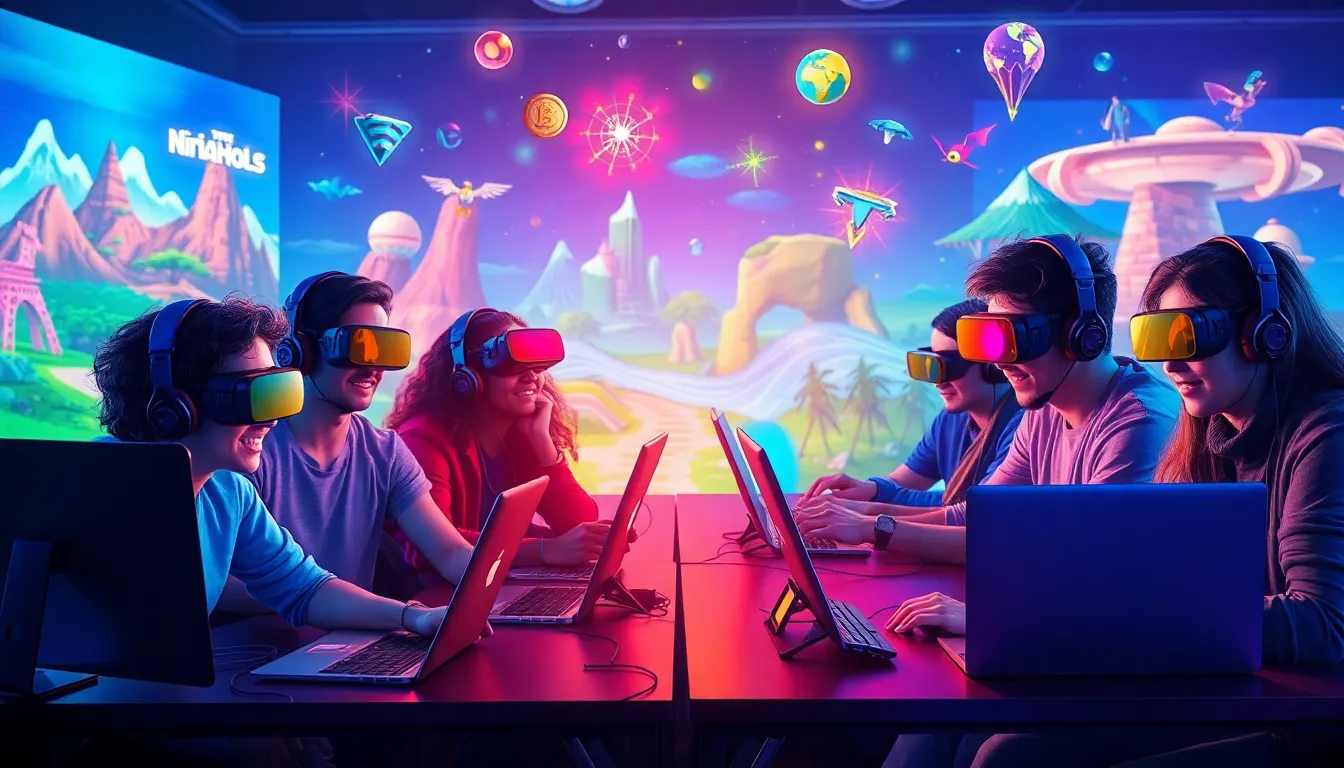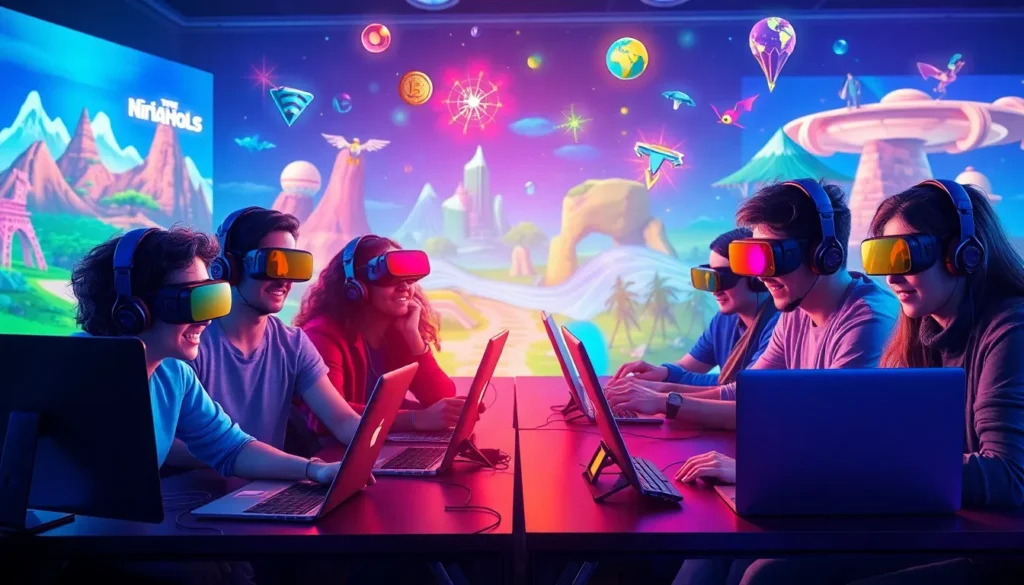Table of Contents
ToggleBlockchain gaming is revolutionizing the way players interact with virtual worlds. By integrating decentralized technology, these games offer unique opportunities for ownership and transparency that traditional gaming can’t match. Players can truly own their in-game assets, trade them freely, and even earn real-world value from their gameplay.
As the gaming industry rapidly evolves, blockchain technology is at the forefront of this transformation. With its promise of security and fairness, it’s attracting both gamers and developers alike. The fusion of gaming and blockchain not only enhances the gaming experience but also opens up new revenue streams and business models. In this article, we’ll explore the exciting developments in blockchain gaming and what the future holds for this dynamic intersection of technology and entertainment.
What Is Blockchain Gaming?
Blockchain gaming uses blockchain technology to create decentralized virtual environments. These games enable players to own assets as non-fungible tokens (NFTs), ensuring true property rights over in-game items. Players can trade, sell, or use these assets across different platforms.
Blockchain gaming emphasizes transparency and security. Smart contracts govern the game mechanics, reducing fraud and promoting fair play. This process also fosters trust among players, as actions and transactions within the game are recorded on an immutable ledger.
Economic models in blockchain gaming allow players to earn real-world value. They can generate income through gameplay, leveraging their skills in earning tokens or selling rare items. Projects like Axie Infinity and Decentraland exemplify the potential of this new gaming paradigm, where players actively participate in the economy.
As the gaming landscape evolves, blockchain technology is driving innovation. Developers are now focusing on integrating these systems into game design, enhancing player experiences and opening new revenue streams. Blockchain gaming stands as a significant evolution, merging entertainment with financial opportunity in a dynamic, interactive setting.
Benefits of Blockchain Gaming

Blockchain gaming introduces significant benefits that enhance the gaming experience. Key advantages include decentralization, true ownership of assets, and transparency in transactions.
Decentralization
Decentralization empowers players by eliminating the reliance on central authorities. Players directly interact with the game environment, ensuring a democratized experience. Decentralized networks prevent censorship, allowing for free expression and creativity without interference. Additionally, this structure mitigates server downtime risks inherent in traditional gaming, fostering a seamless experience.
Ownership of Assets
Ownership of assets defines blockchain gaming. Players truly own in-game items as non-fungible tokens (NFTs), granting clear and verifiable property rights. This guarantees players’ abilities to trade, sell, or use these assets across different gaming platforms. Unlike conventional gaming, where assets remain locked within a game, blockchain provides freedom and flexibility, allowing players to monetize their gaming accomplishments effectively.
Transparency in Transactions
Transparency in transactions enhances trust among players. Blockchain’s immutable ledger records every transaction, making it easy to verify all actions within the game. This feature reduces instances of fraud, as players can trace ownership and transaction history effortlessly. Security measures ensure that each transaction is secure, thus fostering a sense of confidence in the gaming ecosystem.
Challenges Facing Blockchain Gaming
Blockchain gaming faces several challenges that could impact its growth and adoption. Key obstacles include scalability issues and regulatory concerns, which can hinder user experience and market entry.
Scalability Issues
Scalability poses a significant challenge for blockchain gaming. Current blockchain networks often struggle to process high volumes of transactions quickly. For instance, Ethereum can handle approximately 30 transactions per second, leading to congestion during peak times. Such limitations result in high gas fees and slower transaction confirmations, which frustrate players seeking smooth gaming experiences. Solutions like Layer 2 scaling solutions and alternative blockchains aim to improve transaction throughput, but widespread adoption remains a concern. Without effective scaling, gameplay could suffer and deter potential users.
Regulatory Concerns
Regulatory uncertainty presents another hurdle for blockchain gaming. Many jurisdictions lack clear guidelines, creating an unpredictable environment for developers and players. Issues surrounding NFT ownership, cryptocurrency usage, and data privacy are often undefined, leading to confusion. Regulatory bodies may impose restrictions on blockchain games resembling gambling or lacking consumer protections. This unpredictability affects investment in the sector, as developers may hesitate to launch new projects without a clearer regulatory framework. Addressing these concerns through dialogue with regulators could foster a more stable environment for blockchain gaming.
Popular Blockchain Games to Explore
Numerous blockchain games showcase unique mechanics, allowing players to immerse themselves in innovative experiences while earning and trading digital assets. Here are two prominent examples that exemplify the capabilities of blockchain gaming.
Axie Infinity
Axie Infinity stands as a leading player in the blockchain gaming space, leveraging non-fungible tokens (NFTs) to facilitate gameplay. Players engage in battles using fantasy creatures called Axies, which are tradable as NFTs. This ownership aspect enables players to sell or breed Axies, generating real-world income. The play-to-earn model attracts millions, empowering players to earn while they play. As of 2023, Axie Infinity boasts over 2 million daily active users, solidifying its position in the blockchain ecosystem.
Decentraland
Decentraland offers a virtual reality world where players can create, explore, and interact with a decentralized metaverse. Users purchase, sell, and develop parcels of virtual land as NFTs. This unique property ownership model encourages creativity and entrepreneurship. Players can host events, build games, or create art to enhance their land while earning from these activities. The platform supports social interactions and economic ventures, making it a leading example of blockchain’s potential in creating expansive, user-driven experiences. Current statistics reveal over 300,000 monthly active users engaged in this dynamic virtual environment.
The Future of Blockchain Gaming
Blockchain gaming continues to evolve, promising new experiences and enhancements for players worldwide. Emerging trends and potential developments shape the future of this innovative sector.
Emerging Trends
Blockchain gaming showcases several emerging trends that enhance player engagement and ownership.
- Play-to-Earn Models: Players earn real-world value through gameplay, incentivizing participation. Successful titles like Axie Infinity set a precedent, encouraging developers to adopt similar economic frameworks.
- Interoperability: Increasingly, games allow asset transfers across different blockchain ecosystems. This interoperability enables players to utilize their NFTs in multiple games, broadening the gaming experience and fostering a more connected ecosystem.
- Decentralized Autonomous Organizations (DAOs): Some blockchain games incorporate DAOs for governance decisions, empowering players with a voice in the development process. This approach fosters community engagement and drives interest around projects.
- Increased Focus on User Experience: Developers are prioritizing user-friendly interfaces and seamless integration of blockchain technology. Simplifying blockchain interactions helps attract mainstream gamers, enhancing adoption rates.
Potential Developments
Blockchain gaming’s trajectory points to several potential developments that could forge new paths in the industry.
- Improved Scalability Solutions: As developers tackle scalability issues, the integration of Layer 2 protocols and alternative blockchains promises efficient transaction processing. Reducing congestion and fees can enhance player experiences and broaden market reach.
- Enhanced Virtual Reality (VR) Integration: The blending of blockchain and VR technologies could create immersive gaming experiences, allowing players to engage with assets in realistic environments. These developments spark interest and elevate gameplay.
- Regulatory Clarity: As regulations evolve globally, clearer guidelines on NFTs and cryptocurrencies could streamline investment and project launches in blockchain gaming. A stable regulatory landscape may encourage more developers to enter the space.
- Sustainability Initiatives: As environmental concerns grow, blockchain gaming is exploring energy-efficient platforms and systems. Developing greener technologies would address concerns related to carbon footprints, attracting eco-conscious players and investors.
Blockchain gaming is reshaping the landscape of interactive entertainment by empowering players with true ownership and transparency. As the industry navigates challenges like scalability and regulatory uncertainty, innovative solutions are emerging to enhance the gaming experience. The potential for play-to-earn models and interoperability between games signals a bright future for this sector. With platforms like Axie Infinity and Decentraland leading the charge, players can look forward to a more engaging and rewarding gaming environment. As technology continues to evolve, blockchain gaming stands poised to redefine how players interact with virtual worlds and each other.







